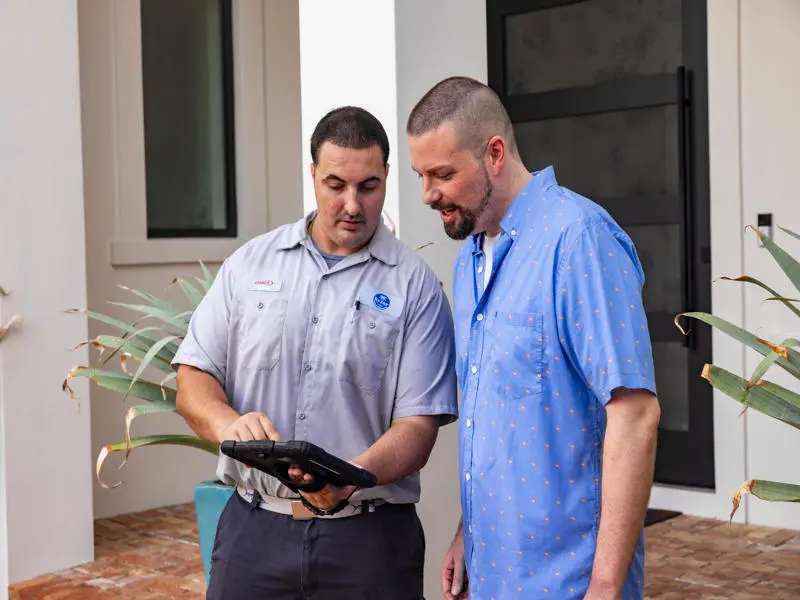
Maintaining healthy indoor air is a priority for homeowners in Port St Lucie, especially given Florida’s humid climate, which can promote mold, bacteria, and other airborne contaminants. One effective way to enhance indoor air quality is through UV sterilization in your HVAC system. UV, or ultraviolet, light can neutralize harmful microorganisms as air circulates through your home. Understanding how this technology works and its benefits can help homeowners make informed decisions about improving comfort and safety.
What UV Sterilization Does in an HVAC System
UV sterilization uses ultraviolet light to disrupt the DNA and RNA of microorganisms such as bacteria, viruses, and mold spores. When installed in an HVAC system, the UV light targets these pathogens as air passes over the coils, drain pans, or duct surfaces. By damaging their genetic material, UV light prevents microorganisms from reproducing, effectively reducing their presence in your home’s air. Unlike standard air filters, which trap particles, UV sterilization actively neutralizes contaminants, providing continuous protection.
Preventing Mold and Mildew Growth
One of the primary benefits of UV light in an HVAC system is its ability to prevent mold growth on system components. Coils and drain pans in air conditioning units often accumulate moisture, creating an ideal environment for mold. If left unchecked, mold spores can circulate throughout your home, causing health issues and unpleasant odors. UV lights installed near the coils inhibit mold growth, keeping your system cleaner and reducing the spread of spores. This is especially important in Florida, where humidity levels are consistently high.
Reducing Bacteria and Viruses
Bacteria and viruses can thrive in the warm, moist environment of HVAC systems. Exposure to these microorganisms can lead to respiratory problems, allergic reactions, or general discomfort. UV sterilization helps reduce the number of bacteria and viruses circulating in the air, lowering the risk of illness. While UV systems are not a replacement for regular cleaning and maintenance, they provide an added layer of protection that enhances overall indoor air quality.
Supporting Allergies and Respiratory Health
For individuals with allergies, asthma, or other respiratory conditions, clean indoor air is essential. UV sterilization works alongside high-quality air filters to reduce allergens such as mold spores, bacteria, and other microorganisms. By lowering the overall microbial load in your home, UV systems can help reduce symptoms like coughing, sneezing, congestion, and throat irritation. Over time, this can create a more comfortable and healthier living environment for your family.
Maintaining HVAC Efficiency
Microbial growth on coils and other components can reduce the efficiency of your HVAC system. Dirt and mold buildup restrict airflow and force the system to work harder, which increases energy usage and can shorten the lifespan of the unit. UV sterilization helps maintain cleaner coils and components, supporting better airflow and more efficient operation. This can lead to lower energy bills and fewer maintenance issues over time.
How UV Sterilization Systems Are Installed
UV lights are typically installed in one of two locations within an HVAC system: near the cooling coils or inside the air ducts. Placement near the coils helps prevent mold growth directly on the surfaces that condense moisture. Duct-mounted systems can further treat the air as it moves through your home. Installation should always be performed by a licensed HVAC professional to ensure proper placement, optimal exposure time, and safe operation.
Maintenance Requirements
While UV sterilization is highly effective, it requires minimal but regular maintenance to remain functional. Most systems need bulb replacement annually, and some units include indicators to signal when a change is necessary. Keeping the system clean and ensuring the bulbs are functioning correctly maximizes the benefits of UV sterilization and protects your indoor air quality over time.
Safety Considerations
UV light is safe when contained within the HVAC system. Direct exposure to UV rays can be harmful to skin and eyes, but when installed properly in coils or ducts, the light is fully enclosed and poses no risk to occupants. Professional installation ensures the system operates safely and efficiently.
Complementing Other Air Quality Measures
UV sterilization works best in combination with other air quality measures. High-efficiency air filters, routine HVAC maintenance, humidity control, and proper ventilation all contribute to cleaner air. Together, these strategies create a comprehensive approach to indoor air quality, reducing allergens, microbes, and other contaminants in your home.
Conclusion
UV sterilization in your HVAC system is an effective way to improve indoor air quality in Port St Lucie homes. By targeting bacteria, viruses, and mold, UV lights help reduce allergens, prevent microbial growth on system components, and support healthier air circulation. Combined with proper maintenance and filtration, UV sterilization can enhance comfort, protect health, and maintain the efficiency of your HVAC system.
For homeowners looking to enhance the air quality in their homes, consulting a licensed HVAC professional is the best way to explore UV sterilization and other solutions. A qualified technician can assess your system, recommend the right UV setup, and ensure it operates safely and effectively. If you want cleaner, healthier air in your home, reach out to a trusted HVAC company in Port St Lucie today and take the first step toward improving your indoor environment.